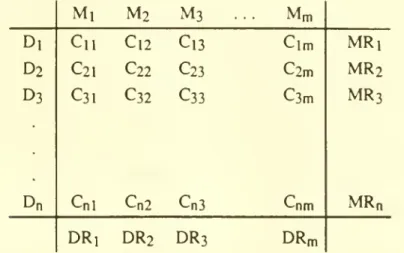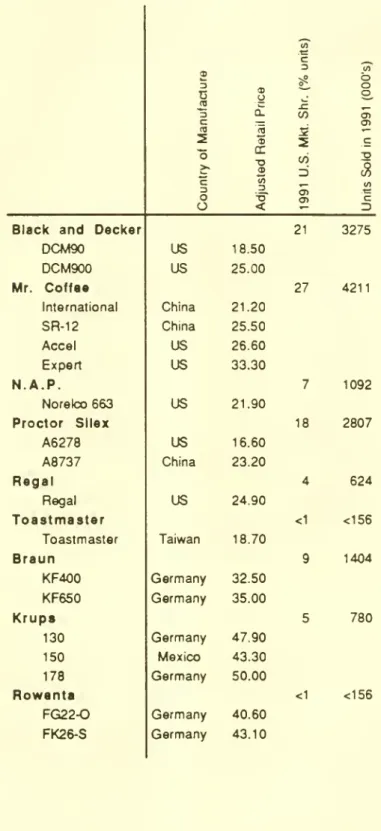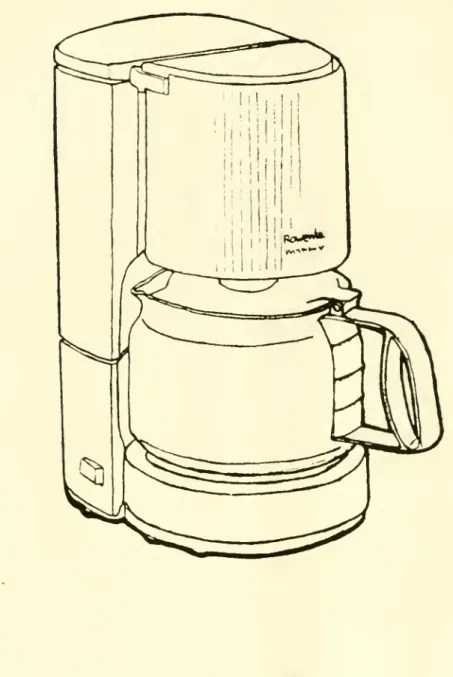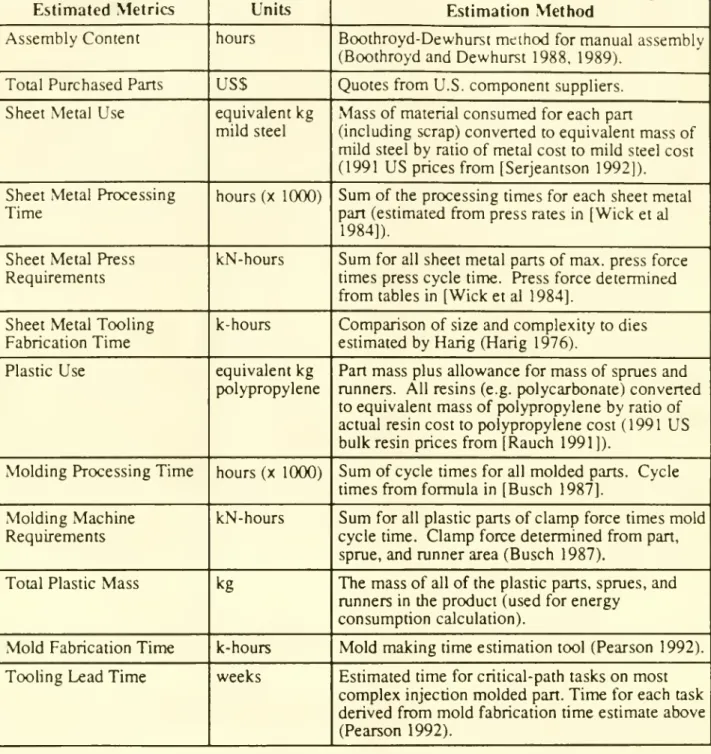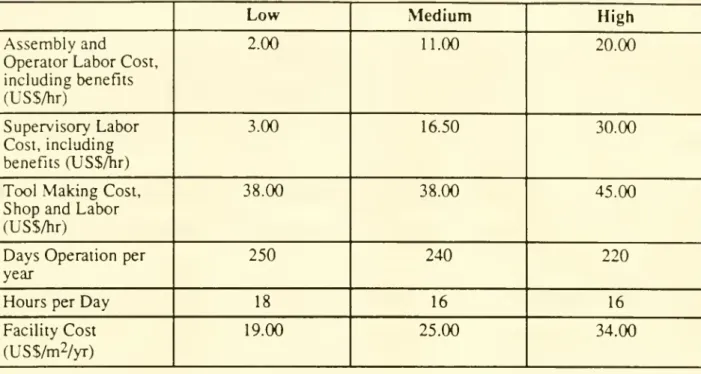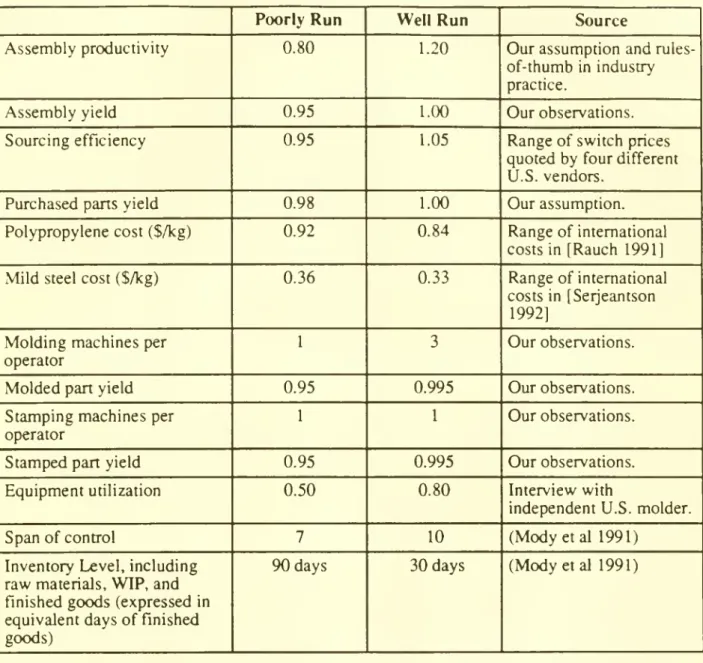HD28
.M414^3>
-UZ:'
WORKING
PAPER
ALFRED
P.SLOAN
SCHOOL
OF
MANAGEMENT
Does
Product
Design
ReallyDetermine
80%
ofManufacturing
Cost?
by
Karl T. Ulrich Scott A.Pearson
WP
#3601-93
August
1993
MASSACHUSETTS
INSTITUTE
OF
TECHNOLOGY
50
MEMORIAL
DRIVE
CAMBRIDGE,
MASSACHUSETTS
02139
Does
Product
Design
ReallyDetermine
80%
ofManufacturing
Cost?
by
Karl T.Ulrich Scott A.Pearson
WP
#3601-93
August
1993
Does Product
Design
Really Determine
80%
of
Manufacturing
Cost?
KarlT. Ulrich* and Scott A. Pearson
Massachusetts Instituteof
Technology
Sloan School of
Management
Cambridge, Massachusetts
02139
Abstract
Many
design researchers and practitionersmotivate theirwork
with the claim that80%
ofthe eventual manufacturingcost ofa productis determinedby the product design.The meaning
ofthis assertion hasnot been well defined, nor has
much
empiricalevidence been presentedtosupport it. This paperaddresses thequestion of
how much
product design influences themanufacturingcostofa product. Indoing so,
we
define the research question formally,we
develop a
methodology
for answering thequestion, andwe
provide a specific answer, undera particularsetof assumptions, fora class ofhigh-volume, electromechanicalconsumer
products—
automaticdrip coffee makers.Our
methodology
includesproductarchaeology, the useofthe product artifactas a sourceofdata, and manufacturingcost modeling.We
find thatforcoffeemakers, the variation inmanufacturing costs attributable todifferencesin product design is
slightly smallerin magnitude than the variation incosts attributable todifferences in
manufacturingsystems, for a specific range of
assumed
manufacturing systemparameters.Acknowledgments
The
researchdescribedin thispaperwas
supported bythe National Science Foundationaspan
of a Strategic Manufacturing Initiative Grantand by theMIT
Leaders forManufacturing Program, a partnershipamong
MIT
and 13 major corporations. E.Yung
Cha
gatheredmuch
ofthe dataon
component
prices andwage
rates.We
are grateful forthemany
people at TredegarMolded
Products
who
generouslyprovided time, data, and insights atvarious stages ofthisproject; inparticularCarl Peasley,
Guy
Vachon,
andDoug
Miller.The
staffofProductGenesis, Inc.contributed to this research byevaluating the industrial designoftheproducts inourdata set.
We
alsoacknowledge
helpfulcomments, on
a previousdraft, by Steven Eppinger, StephenGraves, Chris Kemerer, Richard Locke, and MarcieTyre.
*
Addressallcorrespondenceto thisauthorat
MIT
SloanSchoolofManagement,50MemorialDrive,Room
E53-390, Cambridge,MA
02139,email:ulrich@mit.edu.1. Introduction
Countless product design and developmentresearchers motivate their
work
with references tostudies that reveal thatproduct designdetermines
80%
(orsome
large percentage) of themanufacturing cost ofa product;
we
have used suchreferencesmany
times ourselves.However,
few
references aremade
tothe original studies and little explanation is given for what such aresult might reallymean. For example, awidely usedengineering design textby
Ullman
(1992)displays a table
showing
thatthe design of the product influences70%
ofits manufacturingcost.The
table in Ullman's textisdrawn from
an article in Manufacturing Systems (Miller 1988).The
information in the article is derived
from
an internal Fordstudy.When
we
trackeddown
theFord study, aFord
employee
said, "Oh, thatwas
justan informal survey, I wouldn't base toomuch
on
it." Anotherreference, usedto supportthe claim thatdesign determines80%
ofcost,describes a study in
which
engineers at RollsRoyce
analyzed2000
partdrawings anddiscoveredthat
80%
ofthecostreduction opportunities required changes to the partdesign(Symon
andDangerfield 1980).
The
beliefthatdesign determines80%
ofthe manufacturingcostofa product hasbecome
partof the folkloreof product design and developmentresearchand practice(we
use80%
forconvenience, although the quoted figurevaries
from
70%
to90%).
The
beliefis intuitive,compelling, and is an irresistible introduction toapaperortalk.
The
belief, iftrue, has profoundimplications formanufacturers. Itsuggeststhat productdesign is a
much
bigger leveronmanufacturingcost than otherfactors, such as plant location or operations
management
practices. Consider, however,what
"design determines80%
ofmanufacturingcost" mightreally mean.One
widely held interpretation is thatoncea productis designed,regardless oftheway
themanufacturing system isdesigned andoperated, the
minimum
possible manufacturingcost is80%
ofthemaximum
possible manufacturing cost. There isa basic conceptual flaw in such adefinition.
How
can there beamaximum
manufacturingcost? Imagine, forexample, the rise incost ofa
molded
plastic product as injectionmolding
yieldsdeclinefrom
99%
to1%
due topoorchoicesofproduction process parameters.
Thereis also a basic logical flaw in the argumentthatifthe
minimum
possible manufacturingcost is
80%
of themaximum
possiblemanufacturing costthen product design is a critical activityofthe firm.
The
flaw arisesfrom
the assumption thatmuch
ofthe80%
ofthe cost ofthe productis underthe control ofthe productdesigners. Consider, for example, a firm designing and
producing electrical
components
that forfundamental physical reasonsmust
contain a certainamount
of gold.The
manufacturingcost of thecomponent
may
be largely determined by the costofthe gold.While
in thiscase the design ofthe productdoesimpose
a lowerbound
on manufacturingcost corresponding to the costofthe gold, the product designers have littlecontrolover the cost. For this firm, trading on the gold market, and not product design,
may
be thecritical activity.
This paperaddresses thequestion of
how
much
product design influences the manufacturing cost ofa product. In doing so,we
define the question formally,we
develop amethodology
foranswering the question, and
we
provide a specific answer fora class ofhigh-volume,electromechanical
consumer
products—
automatic drip coffee makers.The methodology
we
present isnot intended for academic inquiry only. Rather,
we
believe themethodology
is usefulto firms attempting to understand the relative leverage they can achievethrough theirdesign and
manufacturing efforts.
The methodology
consistsoftwo
basic steps: (1) useproduct archaeology,orthe study ofthe product artifacts in the marketplace, todetermine the design content ofa groupof productssatisfying the
same
set of requirements, and (2) use a costmodel
toexplorehow
the differencesin design contentrelate todifferences inmanufacturing cost for a set ofdifferent manufacturing
scenarios.
The
paperis organized into six remaining sections. In section 2we
provide theconceptualframework
for ourstudy andwe
define the"80
percent"problem
formally. In section 3,we
describe ourresearch approach. Section4describes the product archaeology
methodology
as applied to the coffeemaker
domain. Section 5 describes the manufacturingcostmodel. Section6details the results and Section 7 is adiscussionofthe results andtheir implications.
2.
Conceptual
Framework
Figure 1 is a simple input-output
model
ofa manufacturingsystem.The
system utilizesequipment, information, tooling, energy, supplies, services, and aworkforce to transform
raw
Costs
may
be incurredin procuring these resources and in disposing ofthe wasteproducts.Over
along timeperiod, the unit costofproducing finished goods can be thoughtofas the costofall
ofthe resources
consumed
(and ofthe waste disposal) overthattime period divided by the totalnumber
ofunitsproduced.Equipment Information Tooling
polycarbonate), and part production processselection (e.g. molding vs. machining). These
decisions in turn constrain the manufacturing activities required toproduce the product.
Conversely, even given a particularproductdesign, manufacturing
managers
and engineers possess substantial latitude in determining the characteristics ofthe manufacturing system.By
manufacturing system,
we
intend not only the basic layout of the plant and choice of process technologies, but themanagement
practices as well.They
can choose different site locations, differentmake-buy
arrangements, anddifferent operationsmanagement
practices.More
formally, for agiven setof product requirements, R,assume
n different product design alternatives, Dj (i= 1 to n). Alsoassume
m
differentmanufacturing system alternatives,Mj
(j=lto m). R,
Mj
and Dj can be thought ofas vectors ofattributes. (Inmost
cases, therewill beinfinite choices of design and manufacturing alternatives, but for simplicity
we
assume
a finiteset.)
The
combination ofadesign and manufacturing system determine a manufacturing cost.We
define Cjj as the unitcost ofmanufacturing design Dj on manufacturing system Mj. Table 1illustrates this concept.
We
define the design range,DRj
,as the range ofthe manufacturingcostsofD\
throughD
nmade
withmanufacturing system Mj.We
definethe manufacturing range,MRj
, as the range ofthe manufacturingcosts ofDj
made
with manufacturing systemsM\
throughM
m
.For a given setof design and manufacturing alternatives,
we
cannow
compare
the design ranges with the manufacturingranges. Ifthe set of designs represents the range ofpossibilitieswe
canconsiderin aproductdesign and ifthe setofmanufacturing systems represents the range of
possibilities for the manufacturing system, then
we
have away
ofcomparing
the latitude inmanufacturingcostdetermined by ourchoice of design tothe latitude inmanufacturingcost
determined by ourchoice ofmanufacturing system. If, for a particular context, the design range
is
much
larger than the manufacturing range thenwe
would
conclude that product design is an important area of focus for the firm. Conversely, ifthe design range is smallrelative tothemanufacturing range,
we
would
concludethat a focuson
the manufacturing systemwould
bemore
appropriate.Although
aconfounding factor in any resource allocation decision is the required investmentto achieve eachofthe alternativesunderconsideration. Also note that ingeneral aproduct
development
organization does not simplychoose adesignfrom
a set offullyofskill andresourcesto be applied tothe design effort in the hope thatthey willachieve a
particular levelof design performance.
Table
1: Unit cost, Qj, arisesfrom
achoice ofdesign,D
u and achoice ofamanufacturing system, Mj.
The
manufacturing range,MR,
is the range ofcosts for thesame
designmade
in different manufacturing systems.The
design range,DR,
is the range ofcosts forall the different designs assuming thesame
manufacturing system.unique process technologies, the coupling between design decisions and manufacturing
capabilities
must
be consideredwhen
the design range and manufacturing range are interpreted.3.
Research
Approach
At
least three questionsarisefrom
the conceptualframework
we
present:How
does onedetermine the set of design alternatives for a particular setof product requirements? (After all, if
one
knew
the setofalternatives, onewould
simply choose the best one.)How
does onedetermine the setofmanufacturing systemalternatives? and
How
can the design alternatives and manufacturing system alternativesbe used toestimate manufacturing costs? In this sectionwe
present ourapproach to these three questions anddiscuss ourchoice of an
example domain
of application.Although
we
take the perspective of researchers in this work,we
contend that themethodology
we
present isappropriate for use by manufacturing firmsas well.How
todetermine the setofdesign alternativesWithin ourconceptual
framework
adiscrete setof designs is used torepresent the latitude a firm possesses in designinganew
product.We
use the product designscurrently available in themarketplace toapproximate the setofalternativesavailable toa firmdesigning a
new
product. This approach requires thatthere be a relatively largenumber
of products and firmscompeting inthe marketplace
from which
we
can infer the expectedcharacteristicsofanew
design.The
approach alsoassumes
thatthe range ofcapabilities anddesign effortamong
the different firms represents the distributionofcapabilitiesand design effort thatcould be exhibited in anew
design. In taking this approachwe
explicitlyexcluderadical departuresfrom
the practices ofthe existing firms in the marketplace. Radicaldesign approaches might be classified asadvanced
developmentrather than productdesign.Inorder todetermine the attributes ofthe setofdesigns,
we
analyzethe actual physical products available in the marketplace.We
call this approach product archaeology—
the study ofindustrial practices by measuringcharacteristics ofthe physical product itself. Product
archaeology is similar to the competitive
benchmarking
some
firms performwhen
analyzing theircompetitors' products
(Camp
1989). In fact,themethodology was
inspired bya visit totheGeneral
Motors
VehicleAssessment
Centerwhere
dozensof competitors' products aredirectly observe factors like the
number
ofpans and thenumber
offasteners, andwe
can use established estimation techniques fordetermining otherfactors such as the assembly laborcontent and the processing requirements forthe fabricated parts.
While
several researchers have used the productas the unit ofanalysis (Clark and Fujimoto1991,
Henderson
and Clark 1990, Sanderson andUzumeri
1992),we
know
of noresearch onproduct design that has
examined
the artifact itselfas a source ofdata.As
aresearchmethodology, product archaeology offers several benefits. First, dataderived from observations
ofthe product itselfare highlyreliable. Unlike the
human
subject of an interview, the productcannot forget and cannotmisrepresent facts. Second, the dataarereadily available. Researchon
dozens ofmanufacturers' products can be performed without permission, access tothe
company,
ortravel. Third, the data obtained from productarchaeology are public information. This allows
researchers to talk about specific manufacturers by
name
and allowsthe actual undisguiseddatato be published.
How
todetermine the setof manufacturing systemalternatives?The
setofmanufacturing systems in ourconceptualframework
represents the set ofalternatives a manufacturerwould
have in setting up and operating a manufacturingsystem. Ifthis analysiswere performedwithin the context ofa specific firm, the setofalternatives mightrepresent the
different possible operating conditionsfor the firm's existing plantsand any
new
plants underconsideration.
These
systems mightbe characterized by, forexample,wage
rates, availableraw
materials prices, and expected processingyields.
As
mentioned inthe introduction, there isno
theoretical upper
bound on
manufacturingcost, sothe rangeofmanufacturing systems should represent the bestand worst systems thatcould reasonably be considered foranew
product. Forthe purposesofthis paper,
we
willmake
assumptions about the operatingparameters of a setofmanufacturing systems based
on
the literatureand ourpreviousresearch.How
tocombine
a designalternativeand
a manufacturing systemalternative todeterminea manufacturing cost?We
use a costmodel
toestimate a manufacturingcost for a particulardesign produced byaparticularmanufacturingsystem.
Our
model
is basedon
many
previousmodeling
efforts byusand other researchers (Surietal 1993,
Mody
et al 1991,Busch
1987, Ulrich etal 1993).The
model
can bemore
or lesssophisticated, butmust
capture the impactofthe majordifferences indesign factors and in manufacturing system factors. For example, one aspect ofthe
model
mightbe assembly cost.
The
model
might take the estimated assembly content ofa product and apply an assembly productivity factor anda laborcost factor to estimate the assembly cost.The
assembly content is derived from the design, while the productivity and labor cost factors arecharacteristics ofthe manufacturing system.
Example
Domain:
CoffeeMakers
We
use anexample
to illustrate themethodology
andtomake
the conceptualframework
specific.We
chose automatic drip coffeemakers
as the product forour study for threemain
reasons.First, there are
many
coffeemakers
thatimplement
thesame
setof product requirements.Each
model
in our sample isdesigned around thesame
brewing process and, according toConsumer
Reports, delivers coffee that is ofequalquality
(Consumer
Reports 1991). Thisallows us toavoid differences in manufacturing costs due todifferences in product requirements. Second,
coffee
makers
are relatively simple.The
components
of coffeemakers
are largeenough
toexamine
easily and sufficiently limited innumber
tomake
the study manageable. Third, coffeemakers
are produced by adiverse groupofmanufacturers—
large and small, U.S. andinternational.
We
anticipate that this diversity will be associated with a wide range ofapproaches todesign.
We
believe thatthe design of coffeemakers
involvesmany
ofthesame
issues as the designofmany
consumer
and industrial products includingpower
tools, automobile ins jment panels, andconsumer
appliances.These
products are high-volume, discrete, assembledgoods
involvingmechanical and electrical components. Similar core technologies that remain relatively stable
overtime are
employed
withineach of these classes.The
specificmodels
and manufacturers forour sampleareshown
in table 2. For reference purposes,we
listthe retail priceofeach coffeemaker
(adjusted fordifferences infeatures, such asclocksand
timers), the market share ofthe manufacturer, thenumber
ofunits sold by each manufacturer each yearin the United States, and the country inwhich
the product is made.Table
2: Basic information about the coffeemaker
manufacturers and models.Figure2:
An
example
coffeemaker from
the data set, theRowenta
FG22-0.4.
Using Product Archaeology
toDetermine
DesignContent
In order todetermine the design contentofthe 18 coffee makers,
we
first established values for asetof metrics through directobservations ofthe products and theirconstituent pans.
We
then estimated additional metrics throughcalculations orbysoliciting informationfrom
vendors.We
disassembled eachproduct andcreated abill ofmaterials(BOM)
and a feasible sequence ofassemblyoperations.
An
example
BOM
is included inAppendix
A. Four metricscan beobserveddirectly
from
theBOM
and the piece parts: the totalnumber
ofparts, thenumber
of partnumbers
(unique parts), thenumber
ofplasticmolded
parts, and thenumber
offasteners (includes screws, nuts, and clips).The
parts fabricated by the manufacturerare either injectionmolded
plasticorstamped sheet metal. For each injectionmolded
part,we
determined the type ofpolymer, thepan
mass, thegeometric complexity, the
pan
wall thickness, thenumber
ofactions(moving
parts) required for the mold, and the percentage ofthe part surface corresponding toeach ofthe five standardsurface finish designations. For each sheet metal part,
we
determined the type ofmetal, the thicknessofthe metal sheet, the requiredlength and width ofsheetconsumed
foreach part, andan estimate ofpartcomplexity
on
a scale of 1 to 5.The
purchasedparts included fasteners, tubing, switches, wiring, heaters, and carafes.We
described the fasteners interms oftheir type and size, tubing in terms of length anddiameter,switchesin termsofthe type (slideror rocker, lightedornot), andwiring in terms oflength,
material, strain relieftype, gage, and color.
We
photographedthe heaters andcarafes. Using thecomponent
data and the photographswe
solicitedprice quotesfrom
U.S. suppliers forproduction quantities of 250,000, 500,000 and 1 million units peryear. (Forour studywe
assume
an annualproduction
volume
of 1 million units, butwe
were interestedin whateconomies
ofscalemay
exist in
component
procurement.The
quotedprices dropby
about10%
asquotedproduction quantities double—
a90%
"learningcurve".)The
metricswe
estimated areshown
in table 3.A
summary
ofeachestimation techniqueislisted. (The details oftheseestimation techniques are in [Pearson 1992].)
The
netresultofthe product archaeology andassociated estimation is the "design content"foreach product. This design contentcan be thought ofas theDj's inourconceptual framework.
Table 4
shows
the valuesofall ofthe design metrics foreachofthe coffee makers.Table
3:The
design metrics derived from the 18 coffeemakers
through the use of product archaeology. All metrics are estimates.y g g S
c
9 : y a. X u y s u = sjauaisejjo on sped snbiun|o om syed P9PI0W(0 on spedjo on(s^aeM)aujixpsai 6ui|oox
(sjnoq-M) 3UJI1uoueouqBd piow
(6-n)SSBWOUSBId IBIOI
(sjnoL(-NM)si,bsyauiqoBiAj6uip|o^
(000Lx sjnoij) sluii6uissaoojd Buipiow
(sua|AdojdA|od 6x Ainba)asnonsBid
.Z (sjnoi|->0 atuiiuoiieouqej6ui|ooiiBja^j ys
y o y § 1 y a
(SjnoM-NX) s;,bsyssajd|B}8|aj lis
(000Lxsjnog)sojij.6uisssoojd|Bjs^ MS
(issispiioi6>( Aba)asnleja^lasiiS
($sn)sped pssBtpjndIBJOi
(sjnoq iqq)luajuooAiqwassy
*- ^ co in cocm en *- cm ^ •- in T t n n co cm
t- cm—
mn
,- cm —--co cm
o
cmco co co coco i- r^ cos
o <o -<r <o"»<* inn- u- t co co n- co in ttco t co it co r^ o r-o £! to t^ in co cd co cm in *-cm — in co cmcd to in o
o
s
CO co o -CMin cm
s
cd cmco r- cmt CM COT COOCO COCOCM CO init
5.
Modeling Manufacturing
CostsWe
adopt the basic costmodel
represented inequation 1. Following is a briefexplanation ofhow
each term is modeled.Appendix
B
gives the specific algebraic expressions relating themanufacturing system parameters and the design parameters from the product archaeology to the
terms in the cost model.
C
=C
assembly+
Cpurchased-parts + ^molded-parts+
^sheet-metal-parts+ Qooling + ^supervision+
^inventory
+ Cf
aciiities +C
energy (1)Where,
forexample,r
assembly - assembly-content x assembly-labor-costassembly-productivity x assembly-yield ^ '
and assembly-content is in unitsof
Boothroyd-Dewhurst
hours, assembly-labor-cost is indollars per hour, assembly-productivity is anon-dimensional ratioreflecting the productivity oftheassembly workforce relative to the
Boothroyd-Dewhurst
metric, and assembly-yield is the fractionofproducts assembled correctly.Assembly
content is a characteristic ofthedesign, while labor cost, assembly efficiencyand assembly yield are characteristics ofthe manufacturingsystem.
The
costofpurchased parts ismodeled by
the pricequoteswe
obtainedfrom
U.S. suppliers divided by asourcing efficiency, reflecting eithermore
orlesseffective purchasing efforts, andapurchased
pans
yield.The
cost ofmolded
parts isdetermined byraw
material usage, cycle time, requiredcapacity,machine
cost, operator wages,molding
yields, andthenumber
ofmachines
run by eachoperator.
The
costof sheet metal partsis determinedin a similar fashion.The
cost of tooling is determined bythe estimatedtooling fabrication time times the tooling shoprate,divided by the tooling life.
The
cost ofsupervision is determinedfrom
the estimatedassembly cost, the assembly laborcost,The
costof inventory is determined from the inventory level, expressed asequivalentdays of finished goods inventory, the unit variable cost, and an inventory holding cost rate.The
cost offacilities isdetermined byestimating the relative size ofa production facilityrequired toproduce 1 million units per year given theassembly and fabrication requirements
determined by the design and other
assumed
manufacturing parameters.A
baseline of5000
square meters of spaceis assumed.
The
cost ofenergy is determinedby estimating the costofmelting and processing the plasticinthe product. This is the
most
significant energy consumption associated with the product.We
did notattempt toestimate the otherenergy requirementsfor stamping, materialshandling, orsmall
power
tools.The
costmodel
does not includemuch
ofwhatwould
normally be considered plantoverhead.There is
no
estimate of purchasing, shipping, receiving, quality control, materials handling, or senior plantmanagement.
As
we
mentioned in section 3, the manufacturing systemparameters usedin themodel
should represent the rangeof reasonable alternatives thatcould be used in producing the product. For anon-going manufacturing firm, these alternatives
would
represent the setof operating conditionsthatmight be encountered in theexisting production facilitiesofthe firm orin any
new
facilitiesunderconsideration. For ourpurposes,
we
considerthe setofmanufacturing systemalternativesthat
may
be usedby any ofthe manufacturersinourdata set.We
know
withcertainty that thesemanufacturers
make
coffeemakers
in a variety of countries with markedly differentwage
rates.We
do
notknow
with certaintywhat
the othermanufacturing parameters are for thesesystems.Our
approach is tobase the assumptionsabout differentmanufacturing systemson
publishedparameters foranalogous production systems inorderto
make
reasonable estimates ofthe range ofmanufacturingcoststhat could be encounteredby these differentmanufacturers.The
manufacturers inourstudymake
productsin atleast 12 different plants (thesum
ofthenumber
ofdifferentcountries inwhich
each manufacturer assembles products). Rather thanconsider 12manufacturing system alternatives,
we
willconsideronly 6,assuming
that several of the manufacturers' plants have quite similarcost structures.The
six plantswe
considercorrespond toa well run and poorly run plant in a low,
medium,
and high-costeconomic
environment.
The
manufacturing parameters driven by theeconomic
environmentareshown
intable 5, while those parametersdriven by the
way
the plant is run areshown
in table 6.The
parameters
we
assume
to be constant forall the plants areshown
intable 7.Table
5:Assumed
manufacturing parameters corresponding to a low,medium,
and high-costeconomic
environment. All values are derived eitherfrom
data supplied by the U.S. Bureau ofLabor
Statisticsor from analogous systemsTable
6:Assumed
manufacturing parameterscorresponding toapoorly run andwell runplant.
The
values based onlyon ourobservations and assumptionsare derivedfrom
ourpriorexperience withmore
than adozen analogous molding,Table
7:Assumed
manufacturing parameters shared across all plants.Molding machine
cost (US$), (Busch 87) basicmolding
machine
costy y y
X
y ~~ 'y •J ^ ac
C '-* MlTable
9: Detailedbreakdown
of estimated costs for theRowenta
FG22-0. Theseestimatedcostscorrespond to awell run plant in the
medium-cost economic
environment.Considera small appliance manufacture with
two
existing manufacturing systems: a well run plant in a high-costenvironment and a poorly run plant in a low-cost environment. Ifthismanufacturer were considering entering thecoffee
maker
market, the manufacturing range mightbe defined by the
two
existing plants plus a well run plant in the low-costenvironment. This setassumes that the firm could invest in improving the performanceof theircurrent poorly run plant
in the low-cost environment and
would
notlet theother plant's operationsdeteriorate.Under
theseconditions, assuming the manufacturing parameters in our study, themanufacturing range
would
be only31%
ofthe average manufacturing cost, while thedesign rangewould
be48%.
Conversely, one can imagine a situation in
which
a firm with an existing low-cost design might have very littledesign range and a large manufacturing range.Industrial designissues
Although the coffee
makers
are functionally identical, they exhibit significant differencesinindustrial design, the aesthetic and ergonomic characteristicsofthe products.
We
suspect thatindustrial design influences
consumer
behaviorand therefore firmsmay
be willing to suffer highermanufacturingcosts inorderto achieve higher levelsof industrial design. In a relatedstudy (Pearson 1992)
we
tested the hypothesis that thequality ofindustrial design is positively correlatedwithmanufacturing cost.We
measured
industrial designquality by asking9professional product designersto rank orderthe 18 products withrespect to aestheticsand
ergonomics. In
summary,
we
foundthat the designers' opinions were consistent with oneanother.
However,
therewas no
significantcorrelation ofeitheraestheticsorergonomics withmanufacturingcost.
We
didfindthat industrial designquality is positivelycorrelated with ourestimate ofone element ofmanufacturing cost, toolingcost, and is positivelycorrelatedwith
estimated toolinglead time (p
<
0.01).One
explanation forthisresult isthat industrial designersalmost alwaysadd geometric complexity toaproduct inorder tocreate visual interest. This
additionalcomplexity
may
notrequiremore
materialorprocessingtime, butmay
requiremore
toolingcomplexity andtherefore
more
tooling costand tooling fabrication time. Becausethe productionvolumes
ofcoffeemakers
are so high, the tooling cost differencesamount
toonly afew
cents perproduct and soare probably not significant factors in determining the costsofgood
industrial design.
Costvs.price
The
manufacturers suggested retail prices for the coffee makers in ourstudy rangefrom
$19.99to $79.99.
Some
ofthis range in price isrelated todifferences in features, such as timers and water level indicators,which
we
did not include in our study ofmanufacturing costs. In our related study,we
adjusted the retail price for these differences in features.The
details ofthisadjustment are in [Pearson 1992]. Although ourcost adjustment procedureis approximate, the hypothesis that cost and price are positively correlated is notsupported byour data.
Some
ofthemost
expensivemodels
have the lowest manufacturing costs, andsome
ofthe least expensivemodels
have relatively high manufacturing costs. For example, theRowenta
FG22-0
sells for a feature-adjusted price of$40.60(unadjusted price is $49.99) whilewe
estimatedits costat $5.92 for a well run plant in amedium-cost
environment.The
Toastmaster sells for a feature-adjusted priceof$18.70 (unadjusted price is $22.99) whilewe
estimated its cost at $7.61.Quality
Perhaps there are differences in manufacturing costs arising from differences in product quality.
In this context
we
intend quality tomean
durability, reliability, androbustness, because aswe
have noted, the quality ofthecoffee
made
bythemodels
isuniform. There are notmany
failuremodes
forcoffeemakers.Based
on interviews withtwo
coffeemaker
designers,we
found thatfailure ofthe heating elements dueto calcification ofthe heatertube is the primary failure
mode
ofthe product. Because allofthe heatingelements have basically the
same
tube geometry, thiscalcification should occurwith equal frequency in all the models. Occasionally the
electromechanical components, the thermostat andswitch, fail.
We
found the costdifferencesamong
themost
expensive and leastexpensive switches and thermostats to be on the orderof$0.20, so the relationship betweenquality andcost is slight. Also, the products with apublic
perception ofquality, primarily the
German
products, exhibitcostsno
higher than average.Plant location vs. design vs. operations
improvement
Given
the costmodel
and thedesign data,we
can exploresome
ofthe decisionsa firm faceswhen
trying toreduce costs. Within ourconceptualframework
there are atleast threeapproaches toreducing costs:
improvements
in design, changes in theeconomic
environment, and changes in productionmanagement
practices. Considera firmin ahigh-costenvironment, such asGermany,
with a poorly run plantand an expensive design.The
firm couldmove
theiroperations toa low costenvironment such as Mexico; they could attempt to improve the
efficiencyof theirproduction system; or they could improve the design ofthe product.
One
ofthe resultsof thisresearch is toquantify the benefits available through an
improved
design.Consider the specific
example
oftheKrups
178, the most costlydesign in our study.Assume
(for purposesofillustration only) that it were
made
in apoorly run plantin ahigh-costeconomic
environment.We
estimate the manufacturing cost underthese conditions tobe $14.54.Krups
could
move
toalow-cost environment, retaining thesame
design. Iftheirnew
plant were poorly run they could reduce theircosts to$9.73. Ifthe plantwere wellrun, they could reduce theircoststo$8.06.
Krups
couldalso redesign theirproduct.Assuming
they couldachieve adesignlike thatofthe
Rowenta FG22-0,
Krupscould reduce theircosts to $9.72 in theiroriginal plant. Iftheyimproved
their plantoperations atthesame
time,they could reduce theircosts to$6.98.Perhaps they could improve theirdesign,
move
their plant,and
improve theiroperations.Under
theseconditions they could achieveacost of$4.98.
Of
course adecision aboutwhere
tofocusimprovements
depends notonly on the savings butonthe required investment.
The
resultwe
findmost
interesting is thatcost reduction through redesignof the productmay
be an extremelyattractive alternative tomoving
operations toalow
cost
economic
environment.Have
manufacturers adoptedconsistentdesignand
plantlocation strategies?O
mightexpectthatfirms operating in high-cost environmentswould
minimizethe assemblycontentoftheirdesigns andthose in low-costenvironments
would
notThe
average estimatedassembly time for the fiveproducts assembledin China,Taiwan, and
Mexico
is 0.105 hours.The
average estimatedassembly timefor the seven productsassembled in the UnitedStates is0.109 hours.
The
six products assembledinGermany
had an average estimated assembly time of0.094hours.
Given
thatthe averageestimated assemblytime forall productsis0.100 hoursandthe range is0.086 hours,
we
do
not find thedifferencesamong
the locations significant.How
todesign a low-costcoffeemaker
Based
on
ourobservationsofthe 18models
in ourstudy,we
can suggestsome
guidelinesforminimizing thecost ofa high-volume electromechanical product like acoffee maker.
Some
of these guidelines are:•
Use
inexpensive materials.The dominant
material forcoffee makers is polypropylene,however
some
ofthecomponents
onsome
ofthemodels
aremade
of polycarbonate, amuch
more
expensive(by a factoroftwo
or three) polymer.The
relative merits of thetwo
materials is covered at length in [Freeze 1991].•
Minimize
the use of material.The
costof the materials in a coffeemaker
is quitesignificant. Both wall thickness and overall
pan
dimensions should be minimized inorderto reduce the use ofmaterial. Careful structural design can achieverigidity while
minimizing the use ofmaterial.
•
Minimize
thenumber
of pans. This is a standard design-for-manufacturingguideline.Adherence
to this guideline through the consolidation of plastic pans results in lessexpensive
molded
pans, because consolidaungtwo
plastic pans reduces tooling costs and minimizes the plastic thatmuch
be scrapped with each shot ofthe injection mold.However,
note thattooling lead timesmay
beextended ifone particularlycomplex
partresults
from
the consolidation offunction. (See [Ulrich et al 1993] for a thoroughdiscussion ofthis issue.) Minimizing the
number
ofpans also, ingeneral, reducestheassembly content ofthe product.
• Concentrate high-quality surface finishes only
where
surfaces are visible. Surface finishis one ofthe
pan
attributescontributing totooling cost and lead time.The
inner surfacesof
pans
do
not have toexhibithigh quality finishes.•
Work
closelywith suppliers tominimize purchased pans costs.From
25%
to50%
of thecost ofacoffee
maker
ismade
up ofpurchased components.Product
Archaeology
as a researchmethodology
Much
ofthe research thathas beendone
in productdevelopment hasrelied on subjectivedatadrawn from
interviews and surveys. For example, in theMrT
InternationalMotor
VehicleResearch
Program
study (MacDuffie 1991), the design-for-assembly variable forautomobileswas
determined byasking manufacturers to subjectivelyrate the ease ofassembly of other manufacturers' products. In ourview,many
of the success factorsofproduct development aredifficult to address at an aggregate level based
on
subjective data.We
have developed theproduct archeology
methodology
as an approach to gathering objective datafor productdevelopment
research.The methodology
offers several benefits.A
relatively large sample sizecan be explored withoutintensive interaction with
many
manufacturers.The
artifact providescompletely accurate data; itdoesn't forget, omit,ormisrepresent information.
Because
theReferences
Appliance,
"Annual
Home
Appliance Market Data",A
Dana
Chase
Publication, September,1991.
Boothroyd, G. and Dewhurst,P., "Product Design for Manufacture and Assembly", Manufacturing Engineering, April 1988.
Boothroyd, G. and Dewhurst, P., Product DesignforAssembly, Boothroyd Dewhurst, Inc.,
Wakefield, RI, 1989.
Boothroyd, G., "Design forAssembly",
Mechanical
Engineering, pp. 28-31, February 1988.Busch, John V., "TechnicalCost
Modeling
ofPlastic Fabrication Processes," Doctoral Thesis,MIT
Department of Materials Science and Engineering, Cambridge,MA
1987.Camp,
R.C.,Benchmarking,ASQC
Quality Press, 1989.Clark,
Kim
B. and Takahiro Fujimoto,ProductDevelopment
Performance: Strategy,Organization,
and
Management
in theWorld
Auto Industry,Harvard Business School Press,Boston 1991.
Consumer
Reports ,"Drip CoffeeMakers
—
Ratings", pp. 42-46, January 1991.Freeze, Karen
"Braun
AG:
The
KF40
Coffee Machine",DesignManagement
InstituteCase
Study, Boston,
MA,
1990.Harig, Herbert, Estimating Stamping Dies, Harig Educational Systems, Philadelphia,
PA
1976.Henderson,
Rebecca
M.
andKim
B. Clark, "Architectural Innovation:The
Reconfiguration of Existing Product Technologies and the Failure of Established Firms," AdministrativeScience Quarterly, Vol. 35, p. 9-30, 1990.MacDuffie,J.P.,
"Beyond
Mass
Production—
FlexibleProduction Systems and Manufacturing Performance in theWorld Auto
Industry",MIT
Sloan SchoolofManagement
Thesis,Management
Ph.D. 1991.Miller, Frederick M., "Designfor Assembly: Ford's BetterIdea to
Improve
Products,"ManufacturingSystems,
March
1988.Mody,
Ashoka, Rajan Suri, Jerry Sanders, andDavid
VanZoest,"International Competition inthe
Footwear
Industry:Keeping
Pace withTechnological Change," Industry SeriesPaper No. 51,The
World
Bank,Washington,DC, December
1991.Mody,
Ashoka, Rajan Suri, Jerry Sanders, andMohan
Tatikonda, "International Competition inPrinted Circuit
Board
Assembly:Keeping
Pacewith Technological Change," Industry SeriesPaperNo. 53,
The
World
Bank,Washington,DC, December
1991.Mody,
Ashoka, Rajan Suri,Jerry Sanders,Chandu
Rao, andFernandoContreras, "InternationalCompetition in the Bicycle Industry:
Keeping
Pace with Technological Change," Industry SeriesPaperNo. 50,
The
World
Bank, Washington,DC, December
1991.Pearson, Scott A.,
"Using
ProductArchaeology to Identify theDimensions
ofDesign DecisionMaking,"
Master's Thesis,MIT
Sloan SchoolofManagement
and Department ofMechanicalEngineering, Cambridge,
MA
1992.Rauch
Guide
tothe U.S. Plastics Industry,Rauch
Associates, Inc., Bridgewater,NJ
1991.Sanderson, Susan and
M.
Uzumeri,"Managing
ProductFamilies:The
Case
oftheSony
Walkman,"
Working
Paper, Rensselaer Polytechnic Institute 1992.Serjeantson, Richard (editor),
Metal
Bulletin sPricesand Data
1992, Metal Bulletin Books,Ltd., Surrey,
UK
1992.Suri, Rajan, Jerry L. Sanders, P. Chandrasekhar Rao, and
Ashoka
Mody,
"Impact ofManufacturing Practices on the Global Bicvcle Industry,"Manufacturing Review, Vol. 6, No. 1,
March
1993.Symon,
R.J. and K.J. Dangerfield,"The
Application ofDesign toCost at Rolls Royce",NATOIAGARD
LectureSeries 107,May
1980.Ullman,
David
G.,The Mechanical
Design Process, McGraw-Hill,New
York
1992.Ulrich, K., Sartorius, D., Pearson, S., and Jakiela, M., "Including the Value of
Time
in Design-for-Manufacturing Decision Making",Management
Science, 1993.Wick, Charles, John Benedict, and
Raymond
Veilleux (editors), Tooland
Manufacturing EngineersHandbook
Fourth Edition,Volume
2: Forming, Society of Manufacturing Engineers,Appendix
A. BillofMaterials for theRowenta FG22-0
CoffeeMaker
PART
Main
tank Base piece FilterconeMachine
coverTank
cover Base plate Potcover Pot handle PotringOne-way
elbow
valveElbow
valveCondenser
Filterbaffle Heaterplate Heat shield Heaterbracket Heatertubes (4) Heater seal Carafe Heater Circlips (5)Screw
(tamperproof) SwitchPower
cordWirel
Wire2
Wire3
Wire4
Wire
sleeves (3) Feet (2)Check
valve-partA
Check
valve-partB
Handle
adhesiveThermostat Thermostat nut
Temperature fuse
TYPE
injection
molded
polypropyleneinjection
molded
polypropyleneinjection
molded
polypropyleneinjection
molded
polypropyleneinjection
molded
polypropyleneinjection
molded
polypropyleneinjection
molded
polypropyleneinjection
molded
polypropyleneinjection
molded
polycarbonate injectionmolded
polycarbonate injectionmolded
polycarbonate injectionmolded
polypropyleneinjection
molded
polypropylenestamped
aluminum
stampedcold- rolled steel
stampedcold-rolled steel
purchased, rubber
purchased, silicone rubber
purchased(Schott)
purchased
purchased fasteners
purchased fastener
purchased toggle, painted
1000
mm,
zig-zag strain relief,one spade, one crimp 100mm,
two
crimps100
mm,
one bare, one spade 100mm,
onebare, one crimp 100mm,
two
crimps purchased, Teflon purchased, rubber purchased, plastic purchased,plastic purchased, thermoset purchased purchased purchasedPage
28Appendix
B:Formulas
forManufacturing
CostModel
The
manufacturing costmodel
consists ofthe terms in the following expression:C
=C
assembly + (-purchased-parts + ^-molded-parts +C
sheet-metal-parts + Ctooling+
^supervision +Qnventory + Cfacilities
+
CenergyIn turn, each ofthe terms is
modeled
as follows (all variables are expressed as hyphenated versions ofthe labels in tables 3, 4, 5, 6 and 7):
assembly-content x assembly-labor-cost assembly -assembly-productivity x assembly-yield total-purchased-parts purchased-pans
-sourcing-efficiency x purchased-parts-yield /- . Cpias UC+
Imolding <~molded-pans"
molded-part-yieldwhere
Cpiastic
=
plastics-use x polypropylene-cost x (1 - plastic-regrind-rate)Cmolding
=
molding-processing-time x(base-machine-rate
+
machine-capacity-rate x molding-machine-requirements+
operator-labor-cost molding-machines-per-operator and ) r(1
+
r)n base-molding-machine-cost base-machine-rate-^
. r ^ n . j xdays-per-yearx hours-per-day xequipment-utilization
r(1
+
r)n molding-machine-capacity-costmachine-capacity-rate
-(1 . r)n . j
x
days-per-yearx hours-per-day x equipment-utilization
r
_
C
meta]+C
stamping<~sheet-metal-parts
-stamped-part-yield
where
CmeiaJ= sheet-metal-use xmild-steel-cost
Qtamping
=
sheet-metal-processing-time x (base-press-rate+
press-capacity-rate x, . . operator-labor-cost \ sheet-metal-press-requirementsr n
+
—
r-* r-. ) stamping-machines-per-operator7 andr(l+r)
n base-stamping-machine-cost base-press-rate=
x j r £—
°\ : rp—
:—
(1 - r)n - 1 days-per-year x hours-per-day x equipment-utilization
r(l+r)
n stamping-machine-capacity-cost size-press-rate=
x j 1—
j—
• t=—
=—
(1 - r)n - 1 days-per-year x hours-per-day xequipment-utilization
and
where
r is the cost ofcapital and n is the useful lifeof the machines.r
(mold-fabrication-time+
sheet-metal-tooling-fabrication-time) x tool-making-costtool-life
division
=
assembly.laborC
^
tm
x b 'lpan-of-conrxol X supefyisorylabor-cost_
inventory-level ,, , ... inventory=
days-operation-per-year x Cvanable x mventory-holding-cost
where
Cvariable
=
^assembly+
Cpurchased-parts+
Cmolded-parts+
Csheet-metal-parts+
Csupervision+
C
energy„
. . ... base-vearly-hoursCfaciliues
=
base-facility-size x-j ; ' r 3—
[dciuucb ^
days-operation-per-year x hours-per-day
x space-utilization-factor x facility-cost x
production-rate
where
space-utilization-factor =3
(ass'y-productivity x ass'y-yield + equip't-utilization x mold-yield + base-inventory/inventory-level)
and base-facility-size is
5000
m
2,base-yearly-hours is4000
hours/year, and base-inventory is60
days.The
space utilization factorassumes
that the required floorspace for agiven annual production isproportional tothe average ofthe yield-adjusted assembly productivity, the yield-adjusted equipment
utilization, and the inventory levels in the plant.
Qnergy =
total-plastic-mass x plastic-processing-energy xenergy-costwhere
plastic-processing-energy hasa value of 0.75 kw-hr/kg (Busch 87).MIT LIBRARIES DUPL
